
- •Welcome to Seagate Crystal Reports
- •Welcome
- •Two kinds of Hands-On tutorials
- •Command, button, key, and control conventions
- •Using Seagate Crystal Reports documentation
- •Seagate Crystal Reports online Help features
- •If you need more help...
- •Installation Requirements
- •Installing Seagate Crystal Reports
- •Installing on a network workstation
- •Upgrading from a previous version
- •Quick Start
- •Subreports expand report usefulness
- •Query Designer adds ad-hoc querying capabilities
- •Parameter fields mean multi-purpose reports
- •Text objects give you text with intelligence
- •Preprinted-form reports easier than ever
- •More powerful formulas extend your capabilities
- •Web solution serves up variety of online reports
- •HTML exporting simplifies Web activities
- •New database support improves data access
- •Running totals made easy
- •Smart Navigation
- •Learning Seagate Crystal Reports
- •User’s Guide
- •Online Help
- •Books Online
- •Sample Reports
- •Glossary
- •Sample Data - CRAZE.MDB
- •Suggested learning paths
- •The application window
- •Menu bar
- •Standard toolbar
- •Supplementary toolbar
- •Format bar
- •Status bar
- •Shortcut menus
- •Cursors
- •Design Tab
- •Preview Tab
- •Other fundamentals
- •HANDS-ON (Report Design Environment)
- •How to add, delete, and move guidelines
- •How to move and position objects using guidelines
- •How to turn the grid on/off
- •How to zoom your report in and out
- •How to undo/redo activities
- •How to drill down on summarized data
- •HANDS-ON (Sections and Areas)
- •How to add, delete, move, and merge sections
- •How to split and resize sections
- •Basic report design
- •How to design a prototype
- •Concepts in reporting
- •Beyond basic reports
- •HANDS-ON (Report Creation and Design)
- •How to select data and begin creating a report
- •How to add and link multiple tables
- •How to insert database fields
- •How to insert special fields
- •How to insert a page n of N field
- •How to insert text objects
- •How to use a database field in a text object
- •How to insert a picture
- •How to select, move, and resize objects
- •How to hide parts of the report
- •HANDS-ON (Finishing Your Report)
- •How to insert page headers and footers
- •How to add a title page to your report
- •How to add summary information to your report
- •Printing considerations
- •Design solutions for printing/distributing
- •Report creation checklist for distributed reports
- •Updating printer drivers
- •Report distribution
- •HANDS-ON (Distributing Your Report)
- •How to export reports
- •How to fax a report
- •How to request reports from a web browser
- •How to specify parameter field values
- •How to log on to a database
- •How to view plain HTML reports
- •Overview
- •Getting started
- •Record Selection
- •Grouping and sorting
- •Completing the report
- •Introduction
- •Working with Arbor Essbase data
- •HANDS-ON (Reporting on OLAP data)
- •How to create a cross-tab with Essbase data
- •Using multiple sections in reports
- •HANDS-ON (Multiple Section Reports)
- •How to work with text objects
- •How to create a form letter using a text object
- •How to format objects conditionally
- •How to print conditional messages in form letters
- •How to alternate background colors for rows
- •How to eliminate blank lines
- •How to add blank lines conditionally
- •Formatting concepts
- •Absolute formatting
- •Types of formatting properties
- •Conditional formatting
- •HANDS-ON (Absolute Formatting)
- •How to add color, shading, and borders
- •How to add/edit lines and boxes
- •How to change margins
- •How to add/delete white space between rows
- •How to set page orientation and paper size
- •HANDS-ON (Conditional Formatting)
- •How to flag values that meet certain conditions
- •Record selection
- •Group selection
- •Record selection formula templates
- •HANDS-ON (Record and Group Selection)
- •How to create a record or group selection formula
- •How to use record/group selection templates
- •How to select the top or bottom N groups
- •Sorting, Grouping, and Totalling Overview
- •Creating custom groups
- •HANDS-ON (Sorting, Grouping, and Totalling)
- •How to do a single field sort
- •How to do a multiple field sort
- •How to group data
- •How to sort records within groups
- •How to summarize grouped data
- •How to subtotal grouped data
- •How to sort based on summarized group values
- •How to create multiple levels of subtotals
- •How to group data in intervals
- •How to calculate a percentage of the grand total
- •How to create group headers
- •What are formulas?
- •Other formula conventions
- •Formula syntax
- •How formulas are evaluated - Order of precedence
- •HANDS-ON (Formulas 101)
- •How to insert a formula in your report
- •How to delete formulas from your report
- •How to copy formulas from online Help
- •How to copy formulas from one report to another
- •How to create if-then-else formulas
- •How to format text with formulas
- •How to use variables in formulas
- •How to declare a variable
- •How to assign a value to a variable
- •How to conditionally assign values to variables
- •How to use an array in a formula
- •How to use a range in a formula
- •How to use semicolons in formulas
- •How to fine tune group selection formulas
- •How to fine tune record selection formulas
- •How to debug a formula
- •Introduction
- •HANDS-ON (Advanced Totalling)
- •How to maintain running totals in a list
- •How to subtotal running totals within groups
- •How to subtotal without grouping
- •How to subtotal true A to B, A to C reports
- •Parameter field objects overview
- •Multiple parameter fields
- •Parameter field considerations
- •HANDS-ON (Parameter Field Objects)
- •How to create a parameter field
- •How to use a parameter field in a formula
- •How to respond to parameter field prompts
- •How to use wildcards with parameter fields
- •How to set a report title using parameter fields
- •How to set sort order using parameter fields
- •Graphing Overview
- •Choosing a graph or chart type
- •Where to place your graph
- •Data you can graph on
- •Before you create your graph
- •HANDS-ON (Graphing)
- •How to graph on a summary or subtotal field
- •How to graph on a details field
- •How to graph on a formula field
- •How to graph on cross-tab summaries
- •How to edit graphs using PGEditor
- •How to use the underlay feature with graphs
- •OLE Objects Overview
- •Inserting OLE objects in your reports
- •Linked vs. Embedded Objects
- •The dynamic OLE menu commands
- •OLE and the Picture command
- •General OLE considerations
- •HANDS-ON (OLE Objects)
- •How OLE objects are represented in your report
- •How to use OLE - General Overview Tutorial
- •How to insert a graphic/picture as an OLE object
- •What are subreports?
- •Unlinked vs. linked subreports
- •How subreport linking works
- •HANDS-ON (Subreports)
- •How to insert a subreport
- •How to preview your subreport
- •How to combine unrelated reports using subreports
- •How to use subreports with unlinkable data
- •Cross-tab overview
- •Cross-tab components
- •HANDS-ON (Cross-Tab Objects)
- •How to create a cross-tab object
- •How to format a cross-tab
- •How to print cross-tabs that span multiple pages
- •The Crystal Query Designer
- •HANDS-ON (Queries)
- •How to create a new query
- •How to add tables to a query
- •How to link tables and specify a join type
- •How to add fields to a query
- •How to identify unique values in a query
- •How to summarize data with aggregate functions
- •How to sort records according to field values
- •How to specify records to be included in a query
- •How to select groups to be included in a query
- •How to create an SQL expression
- •How to create a query from another Crystal Query
- •How to select a query for a report
- •How to use a parameter field in a query
- •Dictionaries Overview
- •HANDS-ON (Dictionaries)
- •How to create a new dictionary
- •How to add a data file
- •How to open an SQL or ODBC data source
- •How to link multiple tables
- •How to select tables and fields for users
- •How to add/create formulas
- •How to move fields/field headings within the list
- •How to update the location of a database table
- •How to add a new field heading
- •How to add Help text
- •How to add a graphic
- •How to create sample data for users to browse
- •How to edit an existing dictionary
- •How to convert a 3.x or 4.x dictionary file
- •How to select a dictionary for a report
- •Databases Overview
- •For additional information
- •HANDS-ON (Working With Databases)
- •How to open Access queries through DAO
- •How to open Access queries through ODBC
- •How to open Access parameter queries
- •How to set up an ODBC data source
- •How to check settings for an ODBC data source
- •How to log on to an ODBC data source
- •How to add an ODBC database table to a report
- •How to log on to MS SQL Server via ODBC
- •How to log off an ODBC data source
- •How to set up an A to B, A to C link
- •How to edit an SQL query
- •How to use an ACT! database
- •How to open the NT Event Log
- •Introduction
- •Four types of data
- •Direct access database files
- •ODBC data sources
- •Crystal Query Designer files
- •Crystal Dictionary files
- •Multi-pass reporting
- •Product support
- •Web support
- •E-mail support
- •Fax support
- •Telephone support
- •Extended technical support policy
- •Product registration
- •Product return policy
- •Product replacement policy
- •Glossary
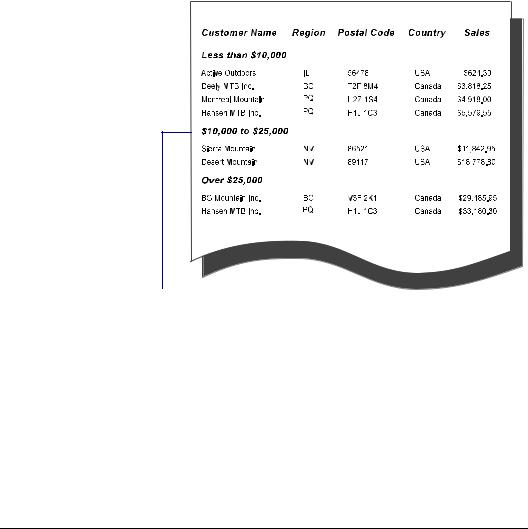
This report is grouped by interval in a specified order.
NOTE: To see an example of the above report, open the
SGT11.RPT file in the \CRW directory.
Related Topics
Formulas 101, Page 321
How to group based on first letter of company name, Page 301
How to create group headers, Page 313
How to calculate a percentage of the grand total
In some reports, you want to see what percentage of the grand total each group contributes. In this example, you will create a report that subtotals orders by country and then determines what percent of total worldwide sales each country generated. The process is simple and straightforward. It uses built-in subtotaling techniques plus one simple formula.
310 |
Seagate Crystal Reports User’s Guide |
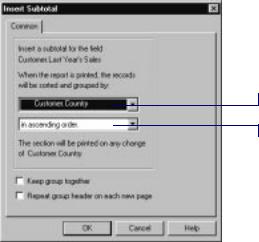
To get started, create a report using the sample data, CRAZE.MDB, and place the following fields from left to right in the Details section:
{customer.CUSTOMER NAME} {customer.REGION} {customer.COUNTRY} {orders.ORDER AMOUNT}
Right-click the Order Amount field and choose the INSERT SUBTOTAL command from the shortcut menu that appears.
!When the Insert Subtotal dialog box appears, specify Country as your sort and group by field and click OK.
This calculates the sales for each country. It breaks your data into country groups and subtotals each group.
This field will
be subtotaled...
whenever the value in this field changes.
"Right-click the Order Amount field again and choose the INSERT GRAND TOTAL command from the shortcut menu that appears. When the Insert Grand Total dialog box appears, make sure that the function is set to sum and then click OK. Search for Summary functions in Seagate Crystal Reports online Help.
Sorting, Grouping, and Totalling |
311 |
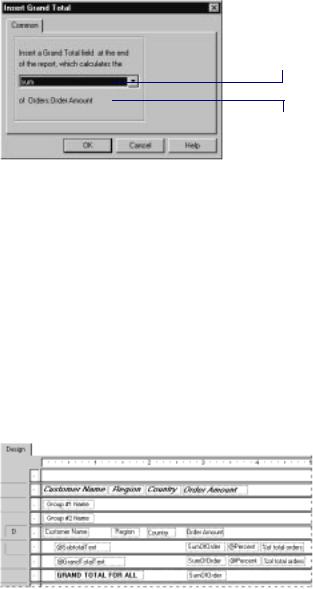
This calculates world wide sales, the total of all sales in the report.
The operation to be performed on the field.
The field that is going to be totaled.
All that is left to do now is to determine the percentage of worldwide sales generated by each country. To do this you will need to create a simple formula.
#Open the Formula Editor and enter the following formula in the Formula text box:
Sum ({orders.ORDER AMOUNT}, {customer.COUNTRY})/Sum ({orders.ORDER AMOUNT})*100
See Formulas 101, Page 321.
$Place the formula in the Group Footer section of the report, just to the right of the Country subtotal.
After you add labels, headers, and formatting, and you run the report, the Design Tab should look similar to this:
312 |
Seagate Crystal Reports User’s Guide |
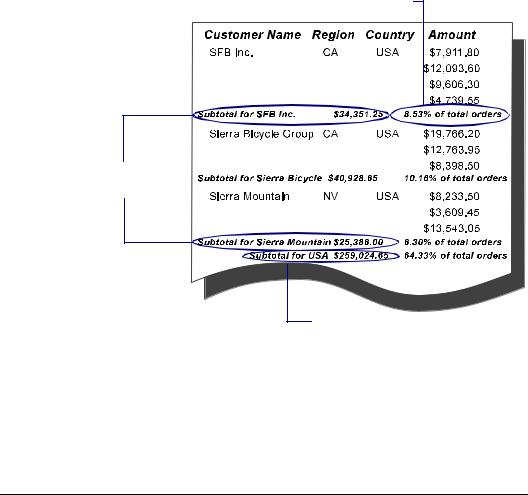
Your report should look similar to the following:
NOTE: This example report has been designed to illustrate concepts only, not the actual look of your finished report.
The program calculates the percent of total sales each customer and each country contributes.
Each customer is subtotaled.
Each country is subtotaled.
NOTE: To see an example of the above report, open the
SGT12.RPT file in the \CRW directory.
Related Topics
Formulas 101, Page 321
How to create group headers
Whenever you create a group, a subtotal, or a summary, the program creates both a Group Footer (GF) section (where it places any subtotal or summary value), and a Group Header (GH)
Sorting, Grouping, and Totalling |
313 |
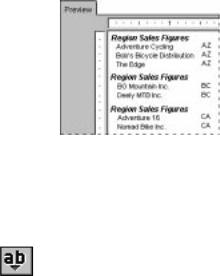
|
section (where it automatically places the group name/header). |
|
Group Headers are useful, even necessary, if you want your |
|
report data to be clear and easily understood. Though the |
|
program creates a group header automatically, you may find that |
|
you would like to change/modify the header to suit your needs. |
|
In this topic you will learn how to create the five most common |
|
kinds of group headers: |
|
● Standard headers, Page 314, |
|
● Live headers, Page 315, |
|
● Live headers for groups based on a formula, Page 317, and |
|
● Headers for custom groups, Page 318. |
Standard |
A standard header is a block of text that is used to identify each |
headers |
group in a rather generic kind of way. “Customer”, “State”, and |
|
“Monthly Orders” are all examples of this kind of header. |
While the header is somewhat descriptive (“Region Sales Figures” clearly means it is a regional group), you never know what region is in the group without first looking at the details in the group.
Nonetheless, this kind of header has its place and it is easy to create.
To create a standard header, click the INSERT TEXT OBJECT button on the standard toolbar.
When the object pointer appears, move the object frame into the Group Header section where you want it to print.
!Click inside the frame to select the object for editing, then enter the text you want to use for your header.
314 |
Seagate Crystal Reports User’s Guide |

Live headers
"Click outside the frame when finished to complete the process. Now when you run the report, the same header will appear at the beginning of each group. See How to insert text objects, Page 120.
A live header is a header that changes based on the content of the group. If you have your data subtotaled by region, for example, a live header would typically identify the region detailed in each group. Thus, the Arizona group would have a header identifying the data as Arizona data, the California group would have a header identifying the data as California data, and so on.
NOTE: When you create a group, the program automatically inserts a group name field in the Group Header section unless you have toggled the option off using the OPTIONS command on the
File menu. The information that follows details how you can manually insert such a section (if you do not have the program insert one automatically) and how to create different kinds of live headers for different needs.
GROUP NAME ONLY
The easiest live header to create is simply an identifying field value. To create this kind of live header for region groups, for example, you simply insert a Group Name field in the Group Header section. This prints Arizona (or AZ) at the beginning of the Arizona group, California (or CA) at the beginning of the California group, and so on.
Click the INSERT FIELDS button on the standard toolbar. The Insert Field dialog box appears.
Click the Group Name Tab to activate it.
!Select the Group Name field that matches the group you are working with and drag it into the Group Header section for that group.
" Format the field as desired.
Now, when you run the report, the region identifier will appear as the group header for each region group.
Sorting, Grouping, and Totalling |
315 |
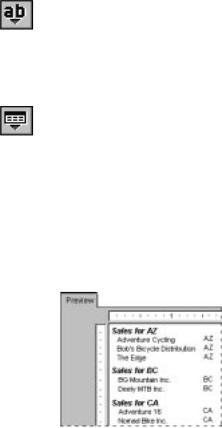
GROUP NAME WITH TEXT
A more complex kind of live header combines text and a field value. A typical group header of this kind for data broken down by region would be, “Sales for California” or “Customers in Postal Code 60606". To create these headers involves three steps:
1.Insert a text object in the Group Header section.
2.Type in the text you want to appear.
3.Enter the Group Name field in the text field where you want it to appear in the Group Header.
For example, if you want your header to read “Sales for” and then the name of the region in the current group (Sales for AZ, Sales for CA, and so forth), follow these steps:
Click the INSERT TEXT OBJECT button on the standard toolbar.
Move the frame for that object in the Group Header section for the group.
!Click inside the object to set the insertion point and type in “Sales for” and a space after it.
"Click the INSERT FIELDS button on the standard toolbar. The Insert Field dialog box appears.
# Click the Group Name Tab to activate it.
$Select the Group Name Field that matches the group, and drag it into the text object, immediately after the text and the space you entered.
% Format the text object as you want it to appear.
Now, when you run the report, the program will create a live header (with text) for each of your groups.
316 |
Seagate Crystal Reports User’s Guide |
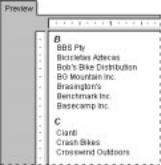
Live headers for
groups based on a formula
When you create a group and use a formula field as a sort and group by field, the program automatically creates a group name field based on the value returned by the formula.
For example, if you create this formula:
{customer.CUSTOMER NAME}[1]
and then group on the formula, the program will group your data based on the first letter in the Customer Name field.
To create a live group header for a group based on a formula, simply insert the group name field in the Group Header section.
When you run the report, the “A” group will have the letter “A” as a header, the “B” group the letter “B”, and so on. For more information, see How to group based on first letter of company name, Page 301.
To create a more descriptive header such as “Customers beginning with the letter B”, you simply follow these four steps:
Insert a text object in the Group Header section. Type in this text:
Customers beginning with the letter
! Add a space.
"Insert the group name field into the text object and place it right after the space.
Sorting, Grouping, and Totalling |
317 |
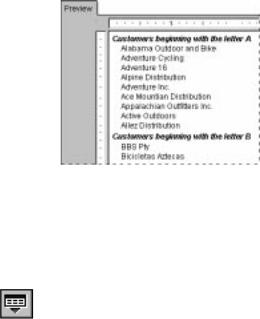
Headers for custom groups
NOTE: If the program automatically inserted a group name field in the Group Header section, you will need to delete that field so you do not have duplicate headers.
The final kind of header is a header for the kinds of custom groups you create when you group things in specified order. When using specified order grouping, you specify the name for each group and the records that belong in it. As in the other grouping situations, the program again creates a group name field for each group based on the group names you specified.
Click the INSERT FIELDS button on the standard toolbar. The Insert Field dialog box appears.
Click the Group Name Tab to activate it.
!Select the Group Name field for the custom group and drag it into the Group Header section for that group.
The program will automatically apply each of the group names you assigned to the appropriate group.
NOTE: Make certain that when you assign the names to the groups using the Define Named Group dialog box, the names you assign are the names you want to appear as group headers.
318 |
Seagate Crystal Reports User’s Guide |
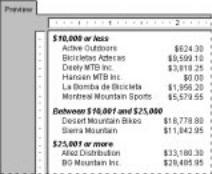
Sorting, Grouping, and Totalling |
319 |
320 |
Seagate Crystal Reports User’s Guide |

13 Formulas 101
What you will find in this chapter...
What are formulas?, Page 322
How formulas are created - An introduction to the Formula Editor, Page 327
Other formula conventions, Page 331
Formula syntax, Page 334
How formulas are evaluated - Order of precedence, Page 337
HANDS-ON (Formulas 101), Page 338
Formulas 101 |
321 |
